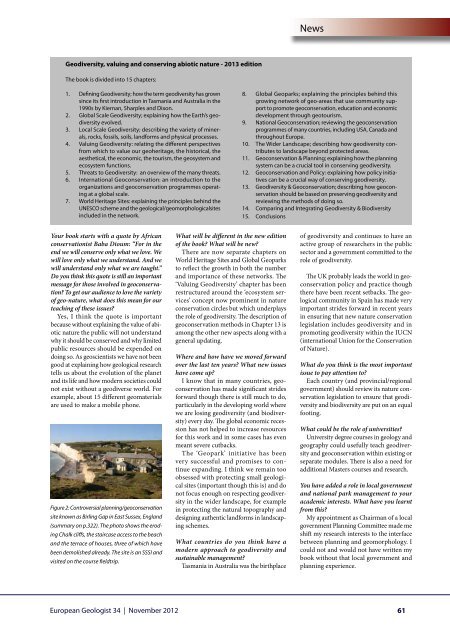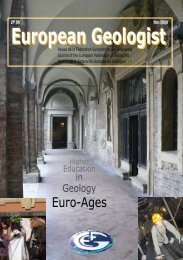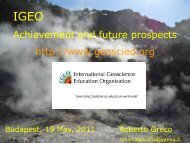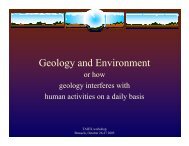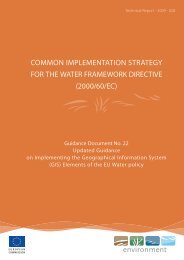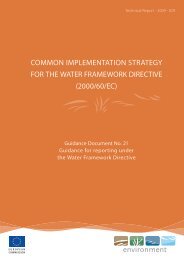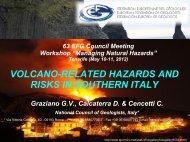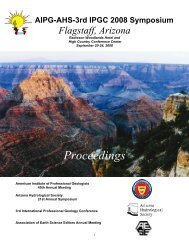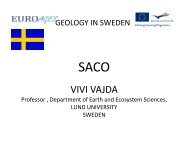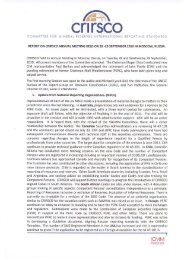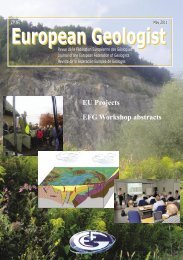European Geologist European Geologist Geoheritage - learning ...
European Geologist European Geologist Geoheritage - learning ...
European Geologist European Geologist Geoheritage - learning ...
You also want an ePaper? Increase the reach of your titles
YUMPU automatically turns print PDFs into web optimized ePapers that Google loves.
News<br />
Geodiversity, valuing and conserving abiotic nature - 2013 edition<br />
The book is divided into 15 chapters:<br />
1. Defining Geodiversity; how the term geodiversity has grown<br />
since its first introduction in Tasmania and Australia in the<br />
1990s by Kiernan, Sharples and Dixon.<br />
2. Global Scale Geodiversity; explaining how the Earth’s geodiversity<br />
evolved.<br />
3. Local Scale Geodiversity; describing the variety of minerals,<br />
rocks, fossils, soils, landforms and physical processes.<br />
4. Valuing Geodiversity: relating the different perspectives<br />
from which to value our geoheritage, the historical, the<br />
aesthetical, the economic, the tourism, the geosystem and<br />
ecosystem functions.<br />
5. Threats to Geodiversity: an overview of the many threats.<br />
6. International Geoconservation: an introduction to the<br />
organizations and geoconservation programmes operating<br />
at a global scale.<br />
7. World Heritage Sites: explaining the principles behind the<br />
UNESCO scheme and the geological/geomorphologicalsites<br />
included in the network.<br />
8. Global Geoparks; explaining the principles behind this<br />
growing network of geo-areas that use community support<br />
to promote geoconservation, education and economic<br />
development through geotourism.<br />
9. National Geoconservation; reviewing the geoconservation<br />
programmes of many countries, including USA, Canada and<br />
throughout Europe.<br />
10. The Wider Landscape; describing how geodiversity contributes<br />
to landscape beyond protected areas.<br />
11. Geoconservation & Planning; explaining how the planning<br />
system can be a crucial tool in conserving geodiversity.<br />
12. Geoconservation and Policy: explaining how policy initiatives<br />
can be a crucial way of conserving geodiversity.<br />
13. Geodiversity & Geoconservation; describing how geoconservation<br />
should be based on preserving geodiversity and<br />
reviewing the methods of doing so.<br />
14. Comparing and Integrating Geodiversity & Biodiversity<br />
15. Conclusions<br />
Your book starts with a quote by African<br />
conservationist Baba Dioum: “For in the<br />
end we will conserve only what we love. We<br />
will love only what we understand. And we<br />
will understand only what we are taught.”<br />
Do you think this quote is still an important<br />
message for those involved in geoconservation?<br />
To get our audience to love the variety<br />
of geo-nature, what does this mean for our<br />
teaching of these issues?<br />
Yes, I think the quote is important<br />
because without explaining the value of abiotic<br />
nature the public will not understand<br />
why it should be conserved and why limited<br />
public resources should be expended on<br />
doing so. As geoscientists we have not been<br />
good at explaining how geological research<br />
tells us about the evolution of the planet<br />
and its life and how modern societies could<br />
not exist without a geodiverse world. For<br />
example, about 15 different geomaterials<br />
are used to make a mobile phone.<br />
Figure 2: Controversial planning/geoconservation<br />
site known as Birling Gap in East Sussex, England<br />
(summary on p.322). The photo shows the eroding<br />
Chalk cliffs, the staircase access to the beach<br />
and the terrace of houses, three of which have<br />
been demolished already. The site is an SSSI and<br />
visited on the course fieldtrip.<br />
What will be different in the new edition<br />
of the book? What will be new?<br />
There are now separate chapters on<br />
World Heritage Sites and Global Geoparks<br />
to reflect the growth in both the number<br />
and importance of these networks. The<br />
‘Valuing Geodiversity’ chapter has been<br />
restructured around the ‘ecosystem services’<br />
concept now prominent in nature<br />
conservation circles but which underplays<br />
the role of geodiversity. The description of<br />
geoconservation methods in Chapter 13 is<br />
among the other new aspects along with a<br />
general updating.<br />
Where and how have we moved forward<br />
over the last ten years? What new issues<br />
have come up?<br />
I know that in many countries, geoconservation<br />
has made significant strides<br />
forward though there is still much to do,<br />
particularly in the developing world where<br />
we are losing geodiversity (and biodiversity)<br />
every day. The global economic recession<br />
has not helped to increase resources<br />
for this work and in some cases has even<br />
meant severe cutbacks.<br />
The ‘Geopark’ initiative has been<br />
very successful and promises to continue<br />
expanding. I think we remain too<br />
obsessed with protecting small geological<br />
sites (important though this is) and do<br />
not focus enough on respecting geodiversity<br />
in the wider landscape, for example<br />
in protecting the natural topography and<br />
designing authentic landforms in landscaping<br />
schemes.<br />
What countries do you think have a<br />
modern approach to geodiversity and<br />
sustainable management?<br />
Tasmania in Australia was the birthplace<br />
of geodiversity and continues to have an<br />
active group of researchers in the public<br />
sector and a government committed to the<br />
role of geodiversity.<br />
The UK probably leads the world in geoconservation<br />
policy and practice though<br />
there have been recent setbacks. The geological<br />
community in Spain has made very<br />
important strides forward in recent years<br />
in ensuring that new nature conservation<br />
legislation includes geodiversity and in<br />
promoting geodiversity within the IUCN<br />
(international Union for the Conservation<br />
of Nature).<br />
What do you think is the most important<br />
issue to pay attention to?<br />
Each country (and provincial/regional<br />
government) should review its nature conservation<br />
legislation to ensure that geodiversity<br />
and biodiversity are put on an equal<br />
footing.<br />
What could be the role of universities?<br />
University degree courses in geology and<br />
geography could usefully teach geodiversity<br />
and geoconservation within existing or<br />
separate modules. There is also a need for<br />
additional Masters courses and research.<br />
You have added a role in local government<br />
and national park management to your<br />
academic interests. What have you learnt<br />
from this?<br />
My appointment as Chairman of a local<br />
government Planning Committee made me<br />
shift my research interests to the interface<br />
between planning and geomorphology. I<br />
could not and would not have written my<br />
book without that local government and<br />
planning experience.<br />
<strong>European</strong> <strong>Geologist</strong> 34 | November 2012<br />
61


